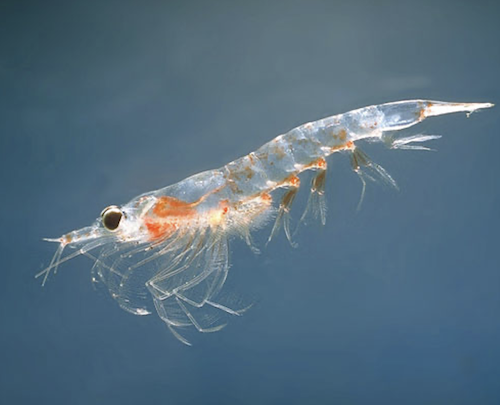69th IWC – Press release n°2
The Euphausia superba, Antarctica’s superb little crustacean, a pillar of the South Pole ecosystem and a staple food for whales, penguins, seals, petrels and other seabirds, is in danger. It may join the dodos, the American migratory pigeons and the great auks of the North Atlantic, deemed to be innumerable and now extinct because of human voracity and short-sightedness.
Euphausia superba grow to 6 cm in length and weigh 2 grams when they reach adulthood (2 years old). They are found exclusively in the Southern Ocean. They live in swarms that sometimes cover dozens of hectares. They feed exclusively on plant plankton. For industrial trawlers, they are an ideal target, recognisable, not very mobile, docile and easy to gobble up, all the more visible as the presence of swarms of krill is revealed by the whale blows. Whales and krill are inseparable. A humpback whale swallows between 1 and 2 tonnes of krill a day, and a blue whale between 4 and 6 tonnes. Whales and Euphausia superba are so inseparable that humpback whales were caught in the trawls of Norwegian krill fishermen (3 in 2021 and one in January 2022).
In 2002, 105,000 tonnes of krill were harvested in the Southern Ocean by 7 trawlers flying the flags of Japan, South Korea, Poland, Ukraine and the United States. In 2022, 415,000 tonnes of krill were harvested by 10 trawlers flying the flags of Chile, China, South Korea, Norway, Russia and Ukraine. A state-of-the-art Norwegian krill-hunting vessel can catch 500 tonnes of krill a day. Based on 2 grams per Euphausia superba, its daily harvest is 250 million individuals.
Krill killers are becoming increasingly powerful and predatory. The first sea trials of the brand new Chinese Fu Yuan Yu 9199 began on September 20, 5 days ago. She is billed as the world’s largest krill fishing vessel, 140 metres long, ice-strengthened, with a crew of 138 in operation.
 Departure of the Fu Yuan Yu 9199 for her trials in the China Sea at Ningde, Fujian province, on September 20, 2024
Departure of the Fu Yuan Yu 9199 for her trials in the China Sea at Ningde, Fujian province, on September 20, 2024
© FuzhouCity
Similarly, Norway, which is currently the dominant country in the krill market, has designed and commissionned what it calls a “revolutionary” factory ship for “green krill fishing”. The hull was launched on November 23, 2021 at the Tersan shipyard in Türkiye. According to our information, she is not yet in operation.
Krill meal is used to feed salmon and other fish farms. It’s a must in aquaculture and aquaria. Antarctic krill in particular provides for the nutritional needs of salmon farms in the Arctic. Krill oil is used in Omega-3-rich food supplements for humans and in supplemented kibbles and canned food for pets. The global krill market is booming.
It’s time to put an end to the sham of krill being considered only as a collective, inexhaustible biomass of several hundred million tonnes. Euphausia superba cannot simultaneously support the redeployment in the Southern Ocean of whales decimated by 70 years of industrial whaling and resist its exponential exploitation.
At the 68th plenary meeting of the IWC in October 2022 in Portoroz, Slovenia, Robin des Bois (Robin Hood) deplored the fact that the negative impacts of krill hunting on whale populations were not being examined.*
The draft resolution on cooperation between the International Whaling Commission and CCAMLR (Commission for the Conservation of Antarctic Marine Living Resources) presented by Hungary on behalf of the Member States of the European Union at the 69th plenary meeting of the IWC is a first step. The draft notes in particular that “krill is a key dietary item for cetaceans as well as other marine species” and calls on “all Antarctic krill-fishing nations to take the measures necessary to eliminate bycatch.”
* “Les baleines dans le rouge” (Whales in the red), October 20, 2022 (only in French)
** “Lima, crucial for whales. 69th IWC – Press release n°1”, September 20, 2024
See also:
Imprisoned, impaled, harpooned, desecrated, June 10, 2024
 Imprimer cet article
Imprimer cet article











